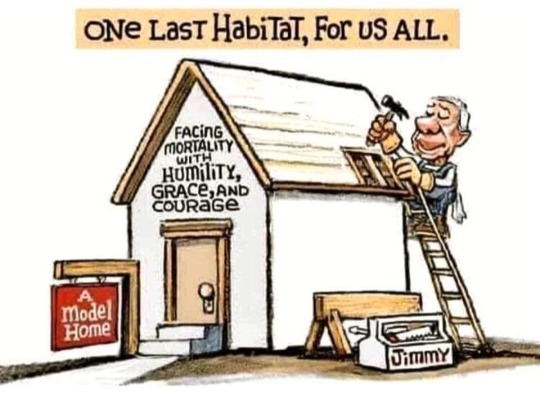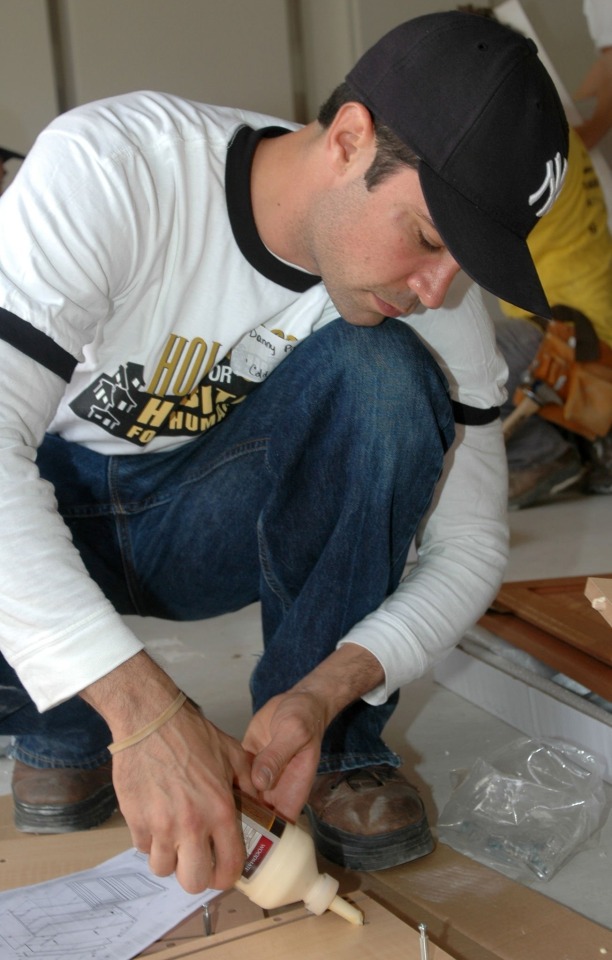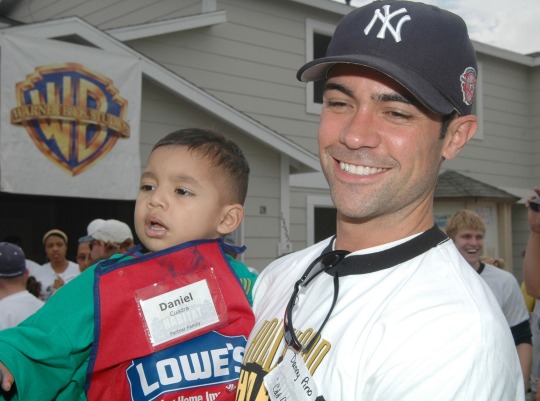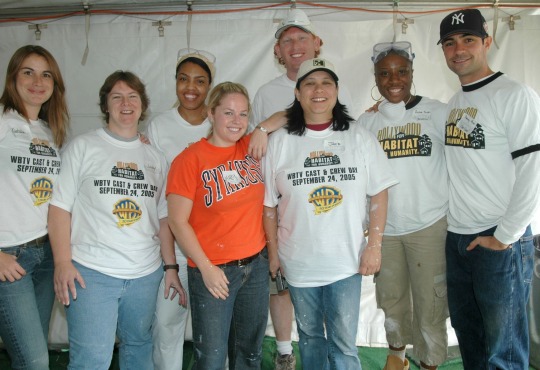#habitat for humanity
Text

#president carter#habitat for humanity#never trump#republican assholes#traitor trump#crooked donald#republican hypocrisy
1K notes
·
View notes
Link
I usually copy a few paragraphs of a story for you guys to review. The only way I could do this story justice, though, would be to copy the entire story.
Instead, I urge you to follow the link. Thanks!
54 notes
·
View notes
Text

#joe fighting 4 his life#patrick stump#joe trohman#andy hurley#2013#habitat for humanity#srar#sunglasses#50
118 notes
·
View notes
Text

23 notes
·
View notes
Text
Former President Jimmy Carter, who at 98 years old is the longest-lived American president, has entered home hospice care in Plains, Georgia, a statement from The Carter Center confirmed Saturday.
After a series of short hospital stays, the statement said, Carter “decided to spend his remaining time at home with his family and receive hospice care instead of additional medical intervention.”
The statement said the 39th president has the full support of his medical team and family, which “asks for privacy at this time and is grateful for the concern shown by his many admirers.”
Carter was a little-known Georgia Governor when he began his bid for the presidency ahead of the 1976 election. He went on to defeat then-President Gerald R. Ford, capitalizing as a Washington outsider in the wake of the Vietnam War and the Watergate scandal that drove Richard Nixon from office in 1974.
Carter served a single, tumultuous term and was defeated by Republican Ronald Reagan in 1980, a landslide loss that ultimately paved the way for his decades of global advocacy for democracy, public health and human rights via The Carter Center.
The former president and his wife, Rosalynn, 95, opened the center in 1982. His work there garnered a Nobel Peace Prize in 2002.
Jason Carter, the couple’s grandson who now chairs The Carter Center governing board, said Saturday in a tweet that he “saw both of my grandparents yesterday. They are at peace and — as always — their home is full of love.”
Carter, who has lived most of his life in Plains, traveled extensively into his 80s and early 90s, including annual trips to build homes with Habitat for Humanity and frequent trips abroad as part of the Carter Center’s election monitoring and its effort to eradicate the Guinea worm parasite in developing countries. But the former president’s health has declined over his 10th decade of life, especially as the coronavirus pandemic limited his public appearances, including at his beloved Maranatha Baptist Church where he taught Sunday School lessons for decades before standing-room-only crowds of visitors.
In August 2015, Carter had a small cancerous mass removed from his liver. The following year, Carter announced that he needed no further treatment, as an experimental drug had eliminated any sign of cancer.
Carter celebrated his most recent birthday in October with family and friends in Plains, the tiny town where he and his wife, Rosalynn, were born in the years between World War I and The Great Depression.
The Carter Center last year marked 40 years of promoting its human rights agenda. The Center has been a pioneer of election observation, monitoring at least 113 elections in Africa, Latin America, and Asia since 1989.
In perhaps its most widely hailed public health effort, the organization recently announced that only 14 human cases of Guinea worm disease were reported in all of 2021, the result of years of public health campaigns to improve access to safe drinking water in Africa. That’s a staggering drop from when The Carter Center began leading the global eradication effort in 1986, when the parasitic disease infected 3.5 million people. Carter once said he hoped to live longer than the last Guinea worm parasite.
Carter was born Oct. 1, 1924, to a prominent family in rural south Georgia. He went on to the U.S. Naval Academy during World War II and pursued a career as a Cold War Naval officer before returning to Plains, Georgia, with Rosalynn and their young family to take over the family peanut business after Earl Carter’s death in the 1950s.
A moderate Democrat, the younger Carter rapidly climbed from the local school board to the state Senate and then the Georgia Governor’s office. He began his White House bid as an underdog with outspoken Baptist mores and technocratic plans reflecting his education as an engineer. He connected with many Americans because of his promise not to deceive the American people after Nixon’s disgrace and U.S. defeat in southeast Asia.
“If I ever lie to you, if I ever make a misleading statement, don’t vote for me. I would not deserve to be your President,” Carter said often as he campaigned.
Carter, who came of age politically during the civil rights movement, was the last Democratic presidential nominee to sweep the Deep South, before the region shifted quickly to Reagan and the Republicans in subsequent elections. He governed amid Cold War pressures, turbulent oil markets and social upheaval over racism, women’s rights and America’s global role.
Carter’s foreign policy wins included brokering Mideast peace by keeping Egyptian President Anwar Sadat and Israeli Prime Minister Menachem Begin at the bargaining table for 13 days in 1978. That Camp David experience inspired the post-presidential center where Carter would establish so much of his legacy. Carter also built on Nixon’s opening with China, and though he tolerated autocrats in Asia, pushed Latin America from dictatorships to democracy.
At home, Carter partially deregulated the airline, railroad and trucking industries and established the departments of Education and Energy, and the Federal Emergency Management Agency. He designated millions of acres in Alaska as national parks or wildlife refuges. He appointed a then-record number of women and non-whites to federal posts. He never had a Supreme Court nomination, but he elevated civil rights attorney Ruth Bader Ginsburg to the nation’s second-highest court, positioning her for a promotion in 1993.
Yet Carter’s electoral coalition splintered under double-digit inflation, gasoline lines and the 444-day hostage crisis in Iran. His bleakest hour came when eight Americans died in a failed hostage rescue in April 1980, helping to ensure his landslide defeat.
For years after his loss, Carter largely receded from electoral politics. Democrats were hesitant to embrace him. Republicans made him a punchline, caricaturing him as a hapless liberal. In reality, Carter governed more as a technocrat, more progressive on race and gender equality than he had campaigned but a budget hawk who often angered more liberal Democrats, including Ted Kennedy, the Massachusetts Senator who waged a damaging primary battle against the sitting President in 1980.
Carter said after leaving office that he had underestimated the importance of dealing with Washington power brokers, including the media and lobbying forces anchored in the nation’s capital. But he insisted his overall approach was sound and that he achieved his primary objectives — to “protect our nation’s security and interests peacefully” and “enhance human rights here and abroad” — even if he fell spectacularly short of a second term.
And years later, upon his cancer diagnosis as a nonagenarian, he expressed satisfaction with his long life.
“I’m perfectly at ease with whatever comes,” he said in 2015. “I’ve had an exciting, adventurous and gratifying existence.”
#us politics#news#president jimmy carter#carter administration#2023#hospice care#cnbc#us history#The Carter Center#rosalynn carter#Habitat for Humanity#election monitoring#Guinea worm parasite#Georgia#peanut farm#Federal Emergency Management Agency#department of education#department of energy#Ruth Bader Ginsburg#Iran hostage crisis#cancer
18 notes
·
View notes
Photo










Danny Pino during WBTV Stars Help Hollywood for Habitat for Humanity commemorate its 5th Anniversary in Los Angeles, September 24, 2005.
Pictures: Alison Buck
#danny pino#habitat for humanity#just because these photos are really sweet#and danny has a huge heart
17 notes
·
View notes
Photo

Yet He did not leave Himself without witness, in that He did good and gave you rains from heaven and fruitful seasons, satisfying your hearts with food and gladness... The God who made the world and everything that is in it, since He is Lord of heaven and earth, does not dwell in temples made by hands; nor is He served by human hands, as though He needed anything, since He Himself gives to all people life and breath and all things; and He made from one man every nation of mankind to live on all the face of the earth, having determined their appointed times and the boundaries of their habitation, that they would seek God, if perhaps they might feel around for Him and find Him, though He is not far from each one of us; for in Him we live and move and exist, as even some of your own poets have said, ‘For we also are His descendants.’ Therefore, since we are the descendants of God, we ought not to think that the Divine Nature is like gold or silver or stone, an image formed by human skill and thought. So having overlooked the times of ignorance, God is now proclaiming to mankind that all people everywhere are to repent, because He has set a day on which He will judge the world in righteousness through a Man whom He has appointed, having furnished proof to all people by raising Him from the dead. ~ Acts 14:17, 17:24-31
3 notes
·
View notes
Text
Rest In Peace mental health advocate, elder care advocate, volunteer for Habitat for Humanity and former First Lady Rosalynn Carter
#Rest In Peace Rosalynn Carter#Former First Lady#habitat for humanity#Elder care advocate#mental health awareness
2 notes
·
View notes
Text
instagram
2 notes
·
View notes
Text
It’s easier to act your way into a new way of thinking than to think your way into a new way of acting.
— Millard Fuller, Founder of Habitat for Humanity
#change#changes#action#habits#millard fuller#habitat for humanity#truth#quotes#quote#how to change#lead with action#favorite
17 notes
·
View notes
Text
Thinking About Jimmy Carter
Jimmy Carter is God’s gift to America as a leader and humanitarian. He also has been an example of faith in action. Habitat for Humanity has been blessed by his and his wife Rosalynn’s work. Peace and comfort to him and his family.
The above image is from The Carter Center Twitter account.

View On WordPress
2 notes
·
View notes
Text
Hello!!
Is there an equivalent to like Goodwill or Habitat for Humanity in Sweden?
Thanks all!!
2 notes
·
View notes
Text
3 Key Takeaways from Financial Literacy Week
Financial literacy week is one of our favorite weeks of the year. During this time, we unite experts in the industry to share tips, tricks and general knowledge about managing finances in a week-long digital event. Our experts cover everything from mortgages, paying off debt, saving for retirement and more.
The virtual event is a full 5-days and is broken up by key topics such as financial foundations, homeownership and family finances – all of which we can’t cover in this article, so feel free to check out all the free content afterward.
Headlined by best-selling author, speaker and CEO of Clever Girl Finance Bola Sokunbi, this year may have been one of the best yet. In case you missed it, here are some of the key takeaways from 2022 Financial Literacy Week.
Discipline is a key ingredient for success
Several of our speakers mentioned the importance of discipline when it comes to achieving short, medium and long term financial goals. Now, ‘discipline’ can be broad word – here are some examples of exhibiting discipline in relation to managing finances:
Creating a budget, and sticking to it. Building a budget may feel like an overwhelming task, however, seeing funds come and go provides greater transparency into what is blocking you from achieving your financial goals
Pay down existing debit as a priority. Debt comes in a variety of forms – student loans, car payments, credit cards and mortgages. The more debt you incur, the more difficult it will be to achieve other financial goals, which is why prioritizing paying down debt is important
Establishing a ‘rainy day fund’, requires a lot of financial displinte but can unlock a secure financial future. According to a 2020 Bank Rate survey, 40% of Americans would borrow money to cover a $1000 emergency (e.g a car accident, medical emergency, urgent home repair) – a scary statistic given the unpredictability of life. Establishing an emergency fund can feel overwhelming, or tempting to pull from, however, it will keep you grounded if anything unexpected were to happen
Look for secure investments such as bonds, dividends and money market accounts and familiarize yourself with the pros and cons of each. Avoid high risk investments such as NFTs, unpredictable IPOs or timeshares
Talk to your kids about money
Learning about taxes, wages and the complexity of personal finances is often brushed off in the classroom. Therefore, if you are a parent or guardian, teaching your children about money management can provide them a life skill which will set them up for a brighter financial future.
Conversations around finances can shape your child’s relationship with money – and you don’t need to be an expert to have these conversations. The opportunity to teach a child about the value of a dollar can come up naturally in everyday life.
For example, if you’re in a shop and your child wants something, explain to them that everyone has limited money therefore we need to be selective about what we spend it on. It’s a good chance to explain needing vs. wanting, and talk about how your family earns money in exchange for items such as clothes, cars and housing. Making the most of these moments will teach them good spending habits for adulthood.
Avalanche and Snowball aren’t only used to describe types of snow
As mentioned, debt can occur in a variety of forms. Additionally each of those forms have different consequences for delayed or partial payment, which is primarily driven from interest rates.
Interest rate is the amount of money you pay to the entity you’re borrowing from on top of the money you borrowed. For example, you may take out a home loan at 5% interest from a bank. That 5% will be added onto your monthly repayments, which is how the bank makes money. The longer it takes you to repay the money you borrowed, the more you’ll end up paying the entity you borrowed from – in this example, the bank.
Managing loan payments can be done with the right strategy in place. In Financial Literacy week, we learned that there are two methods that can be used in paying down debt, the avalanche method and the snowball method. Both strategies have pros and cons and will require research to find out which one is right for you.
The Avalanche method is a more aggressive approach which involves paying extra money towards the debit with the highest interest rate. While the Snowball strategy involves paying down the smallest debt first and working up towards larger debts – regardless of what the interest rate is on the loan.
The Avalanche method is more efficient for debt reduction, but requires more discipline. While the Snowball method does not reduce debt as quickly, it can allow more flexibility if you’re not equipped to pursue the Avalanche approach. Both strategies, however, can reduce debts and provide more financial freedom.
Financial foundations isn’t a skill that is gained overnight
It can take some time to budget, learn and execute strategies to improve your financial health and it doesn’t happen immediately. Habitat for Humanity is one of many organizations that offer a variety of free resources that can help support your journey to financial literacy. If you need help getting started, explore our Financial Literacy videos from this year’s event.

#habitat for humanity in dallas#Dallas Emergency Housing#Dallas Habitat for Humanity Restore#dallas homeless#Dallas Volunteer Opportunities#resources for humanity#Habitat for Humanity in Texas#Humanity Habitat Restore#habitat for humanity#Habitat restore near me#habitat restore
2 notes
·
View notes
Text
September 2022 follower count donation (three digit mark!)
I have about 100 followers now so I’m kind of rounding for the past 4 months I’ve missed: $200 to local butterfly garden charity, $100 to Vote.org, $50 to Habitat for Humanity, $50 to National Park Foundation.
Thanks everyone for following me. It’s been super cool having almost every single post I make get at least 1-2 notes, being seen and liked by at least a few people.
1 note
·
View note
